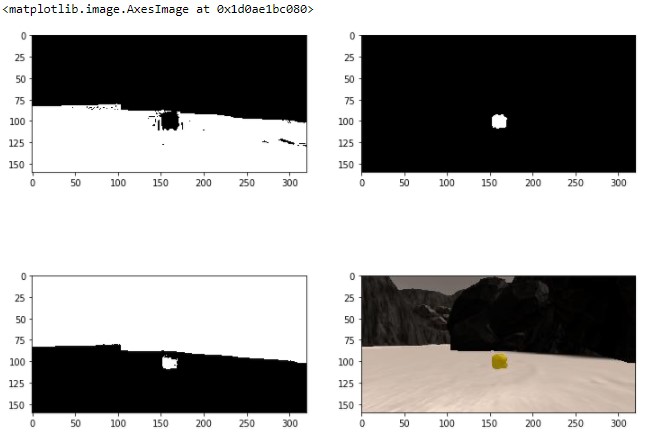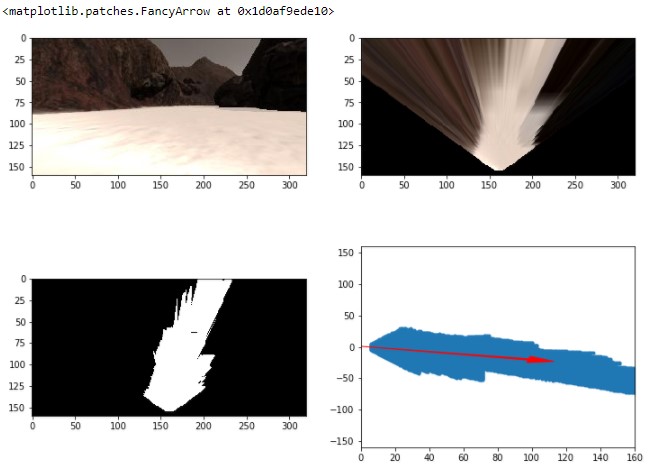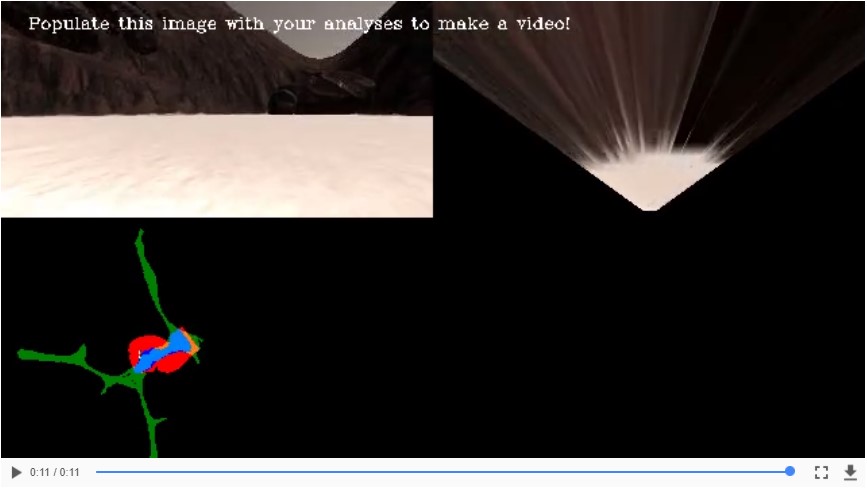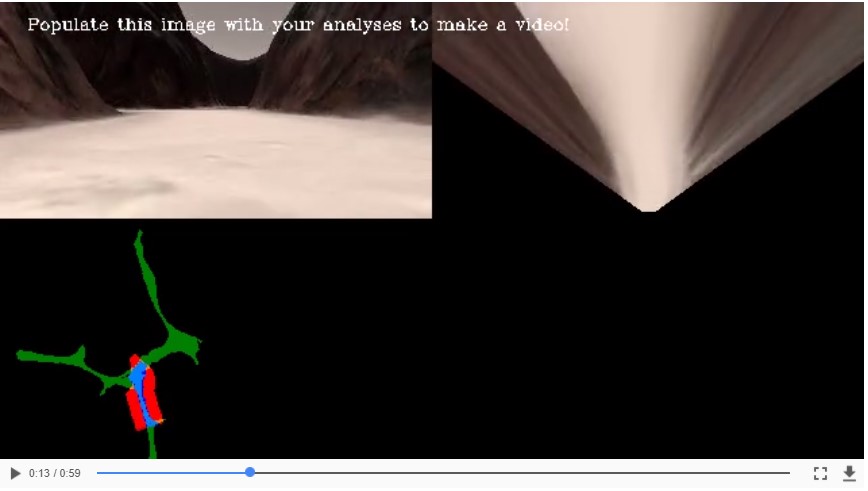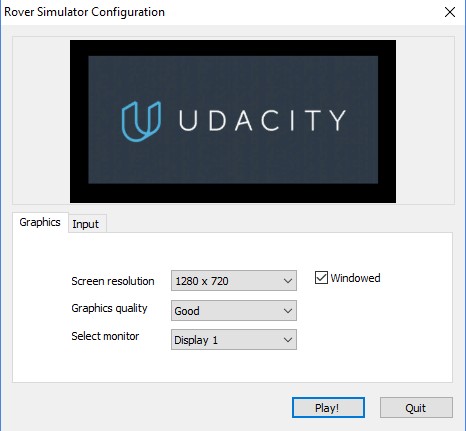The goals / steps of this project are the following:
-
Training / Calibration:
- Download the simulator and take data in "Training Mode"
- Test out the functions in the Jupyter Notebook provided
- Add functions to detect obstacles and samples of interest (golden rocks)
- Fill in the
process_image()function with the appropriate image processing steps (perspective transform, color threshold etc.) to get from raw images to a map. Theoutput_imageyou create in this step should demonstrate that your mapping pipeline works. - Use
moviepyto process the images in your saved dataset with theprocess_image()function. Include the video you produce as part of your submission.
-
Autonomous Navigation / Mapping
- Fill in the
perception_step()function within theperception.pyscript with the appropriate image processing functions to create a map and updateRover()data (similar to what you did withprocess_image()in the notebook). - Fill in the
decision_step()function within thedecision.pyscript with conditional statements that take into consideration the outputs of theperception_step()in deciding how to issue throttle, brake and steering commands. - Iterate on your perception and decision function until your rover does a reasonable job of navigating and mapping. (Mapping 40% of the map, at 60% Fidelity, and locate at least 1 rock sample).
- Fill in the
Rubric Points
1. Provide a Writeup / README that includes all the rubric points and how you addressed each one. You can submit your writeup as markdown or pdf.
1. Run the functions provided in the notebook on test images (first with the test data provided, next on data you have recorded). Add/modify functions to allow for color selection of obstacles and rock samples.
2. Populate the process_image() function with the appropriate analysis steps to map pixels identifying navigable terrain, obstacles and rock samples into a worldmap. Run process_image() on your test data using the moviepy functions provided to create video output of your result.
A. Did a few modifications to different functions. All details are shown in the jupyter notebook 'Rover_Project_Test_Notebook.ipynb'
1. Fill in the perception_step() (at the bottom of the perception.py script) and decision_step() (in decision.py) functions in the autonomous mapping scripts and an explanation is provided in the writeup of how and why these functions were modified as they were.
a. These color_thresh function modifications make it so that it outputs all 3 thresholds, one for navigable path, rock samples, and rock samples; respectively. Thought, red and green thresholds higher than 100 and blue threshold lower than 50 do the trick to recognize the yellow pixels from the rock samples.
def color_thresh(img, rgb_thresh=(160, 160, 160, 100 , 100,50)):
# Create an array of zeros same xy size as img, but single channel
color_select_path = np.zeros_like(img[:,:,0])
color_select_rock = np.zeros_like(img[:,:,0])
color_select_obstacle = np.zeros_like(img[:,:,0])
# Threshold for navigable path
above_thresh = (img[:,:,0] > rgb_thresh[0])
& (img[:,:,1] > rgb_thresh[1])
& (img[:,:,2] > rgb_thresh[2])
# Threshold for rocks
between_thresh = (img[:,:,0] > rgb_thresh[3] )
& (img[:,:,1] > rgb_thresh[4] )
& (img[:,:,2] < rgb_thresh[5] )
# Threshold for obstacles
below_thresh = (img[:,:,0] < rgb_thresh[0])
& (img[:,:,1] < rgb_thresh[1])
& (img[:,:,2] < rgb_thresh[2])
# Index the array of zeros with the boolean array and set to 1
color_select_path[above_thresh] = 1
color_select_rock[between_thresh] = 1
color_select_obstacle[below_thresh] = 1
# Return the binary images for each objects
return color_select_path, color_select_rock, color_select_obstacle
b. Changes to the perspect_transform function generate a second output to consider the outside field of view, which would otherwise be considered part of the obstacles without this method.
def perspect_transform(img, src, dst):
M = cv2.getPerspectiveTransform(src, dst)
warped = cv2.warpPerspective(img, M, (img.shape[1], img.shape[0]))# keep same size as input image
outside_field = cv2.warpPerspective(np.ones_like(img[:,:,0]), M, (img.shape[1], img.shape[0]))
return warped, outside_field
c. Changes to the perception_step() function have been made to apply all the functions previously stated to provide a complete computer vision image that can be used to tell the rover where it can travel and where it can't, as well as adding the ability to detect rock samples.
####### - I also applied the to_polar_coords() function to the rock 'x' and 'y' pixels to provide the rover distance and direction to where the rock samples are, for steering guidance.
def perception_step(Rover):
# Perform perception steps to update Rover()
# TODO:
# NOTE: camera image is coming to you in Rover.img
# 1) Define source and destination points for perspective transform
xpos, ypos = Rover.pos
yaw = Rover.yaw
dst_size=8
bottom_offset=6
world_size = Rover.worldmap.shape[0]
scale = 2* dst_size
source = np.float32([[14, 140], [301 ,140],[200, 96], [118, 96]])
destination = np.float32([[Rover.img.shape[1]/2 - dst_size, Rover.img.shape[0] - bottom_offset],
[Rover.img.shape[1]/2 + dst_size, Rover.img.shape[0] - bottom_offset],
[Rover.img.shape[1]/2 + dst_size, Rover.img.shape[0] - 2*dst_size - bottom_offset],
[Rover.img.shape[1]/2 - dst_size, Rover.img.shape[0] - 2*dst_size - bottom_offset],
])
# 2) Apply perspective transform
warped, outside_field = perspect_transform(Rover.img, source, destination)
# 3) Apply color threshold to identify navigable terrain/obstacles/rock samples
threshed_path, threshed_rock, threshed_obs = color_thresh(warped)
obstacles_world = np.absolute(np.float32(threshed_obs))*outside_field
# 4) Update Rover.vision_image (this will be displayed on left side of screen)
Rover.vision_image[:,:,0] = obstacles_world * 255 #obstacles color-thresholded binary image
Rover.vision_image[:,:,1] = threshed_rock * 255 #rocks color-thresholded binary image
Rover.vision_image[:,:,2] = threshed_path * 255 #terrain color-thresholded binary images
# 5) Convert map image pixel values to rover-centric coords
xpix, ypix = rover_coords(threshed_path)
obs_xpix, obs_ypix = rover_coords(obstacles_world)
rock_xpix, rock_ypix = rover_coords(threshed_rock)
# 6) Convert rover-centric pixel values to world coordinates
x_world, y_world = pix_to_world(xpix,ypix,xpos,ypos,yaw,world_size,scale)
obs_xworld, obs_yworld = pix_to_world(obs_xpix,obs_ypix,xpos,ypos,yaw,world_size,scale)
rock_xworld, rock_yworld = pix_to_world(rock_xpix,rock_ypix,xpos,ypos,yaw,world_size,scale)
# 7) Update Rover worldmap (to be displayed on right side of screen)
Rover.worldmap[obs_yworld, obs_xworld, 0] += 50
Rover.worldmap[rock_yworld, rock_xworld, 1] += 50
Rover.worldmap[y_world, x_world, 2] += 50
# 8) Convert rover-centric pixel positions to polar coordinates
rover_dist, rover_angles = to_polar_coords(xpix, ypix)
rock_dist, rock_angle = to_polar_coords(rock_xpix, rock_ypix)
# Update Rover pixel distances and angles
Rover.nav_dists = rover_dist
Rover.nav_angles = rover_angles
Rover.rock_dists = rock_dist
Rover.rock_angles = rock_angle
a. Made these changes to the decision_step() function to provide the extra capability to locate and steer towards rock samples when found, stop when near a sample, and pickup sample when it has stopped in front of the rock sample.
import numpy as np
# This is where you can build a decision tree for determining throttle, brake and steer
# commands based on the output of the perception_step() function
def decision_step(Rover):
# Implement conditionals to decide what to do given perception data
# Here you're all set up with some basic functionality but you'll need to
# improve on this decision tree to do a good job of navigating autonomously!
# Example:
# Check if we have vision data to make decisions with
if Rover.nav_angles is not None:
# Check for Rover.mode status
if len(Rover.rock_angles) != 0:
Rover.sample_pos_found = Rover.rock_angles
Rover.steer = np.clip(np.mean(Rover.rock_angles * 180/np.pi), -15, 15)
if len(Rover.rock_angles) >= 20:
Rover.sample_pos_found = Rover.rock_dists
if Rover.vel < 1:
# Set throttle value to throttle setting
Rover.throttle = 0.1
Rover.brake = 0
elif Rover.vel >= 1:
Rover.brake = 5
Rover.throttle = 0
else: # Else coast
Rover.throttle = 0
Rover.brake = 0
elif len(Rover.rock_angles) <= 20:
Rover.sample_pos_found = len(Rover.rock_angles)
# Set mode to "stop" and hit the brakes!
#Rover.throttle = 0
if Rover.vel < 0.7:
# Set throttle value to throttle setting
Rover.throttle = 0.1
Rover.brake = 0
elif Rover.vel >= 0.7:
Rover.throttle = 0
Rover.brake = 5
else: # Else coast
Rover.throttle = 0
# Set brake to stored brake value
if Rover.near_sample:
Rover.throttle = 0
Rover.brake = Rover.brake_set
Rover.steer = 0
if Rover.near_sample and Rover.vel == 0 and not Rover.picking_up:
Rover.send_pickup = True
elif Rover.mode == 'forward' and len(Rover.rock_angles) == 0 and Rover.near_sample == 0:
Rover.sample_pos_found = len(Rover.rock_angles)
# Check the extent of navigable terrain
if len(Rover.nav_angles) >= Rover.stop_forward:
# If mode is forward, navigable terrain looks good
# and velocity is below max, then throttle
if Rover.vel < Rover.max_vel:
# Set throttle value to throttle setting
Rover.throttle = Rover.throttle_set
else: # Else coast
Rover.throttle = 0
Rover.brake = 0
# Set steering to average angle clipped to the range +/- 15
Rover.steer = np.clip(np.mean(Rover.nav_angles * 180/np.pi), -15, 15)
# If there's a lack of navigable terrain pixels then go to 'stop' mode
elif len(Rover.nav_angles) < Rover.stop_forward:
# Set mode to "stop" and hit the brakes!
Rover.throttle = 0
# Set brake to stored brake value
Rover.brake = Rover.brake_set
Rover.steer = 0
Rover.mode = 'stop'
# If we're already in "stop" mode then make different decisions
elif Rover.mode == 'stop' and len(Rover.rock_angles) == 0:
# If we're in stop mode but still moving keep braking
if Rover.vel > 0.2:
Rover.throttle = 0
Rover.brake = Rover.brake_set
Rover.steer = 0
# If we're not moving (vel < 0.2) then do something else
elif Rover.vel <= 0.2:
# Now we're stopped and we have vision data to see if there's a path forward
if len(Rover.nav_angles) < Rover.go_forward:
Rover.throttle = 0
# Release the brake to allow turning
Rover.brake = 0
# Turn range is +/- 15 degrees, when stopped the next line will induce 4-wheel turning
Rover.steer = -25 # Could be more clever here about which way to turn
# If we're stopped but see sufficient navigable terrain in front then go!
elif len(Rover.nav_angles) >= Rover.go_forward:
# Set throttle back to stored value
Rover.throttle = Rover.throttle_set
# Release the brake
Rover.brake = 0
# Set steer to mean angle
Rover.steer = np.clip(np.mean(Rover.nav_angles * 180/np.pi), -15, 15)
Rover.mode = 'forward'
else:
Rover.throttle = Rover.throttle_set
Rover.steer = 0
Rover.brake = 0
return Rover
a. Made these changes to the init() function to provide the extra variables to the rover for storing rock sample distance and angles, along with a string variable that's used to prompt in different situations for testing and debugging purposes.
def __init__(self):
self.start_time = None # To record the start time of navigation
self.total_time = None # To record total duration of naviagation
self.img = None # Current camera image
self.pos = None # Current position (x, y)
self.yaw = None # Current yaw angle
self.pitch = None # Current pitch angle
self.roll = None # Current roll angle
self.vel = None # Current velocity
self.steer = 0 # Current steering angle
self.throttle = 0 # Current throttle value
self.brake = 0 # Current brake value
self.nav_angles = None # Angles of navigable terrain pixels
self.nav_dists = None # Distances of navigable terrain pixels
self.ground_truth = ground_truth_3d # Ground truth worldmap
self.mode = 'forward' # Current mode (can be forward or stop)
self.throttle_set = 0.6 # Throttle setting when accelerating
self.brake_set = 10 # Brake setting when braking
# The stop_forward and go_forward fields below represent total count
# of navigable terrain pixels. This is a very crude form of knowing
# when you can keep going and when you should stop. Feel free to
# get creative in adding new fields or modifying these!
self.stop_forward = 100 # Threshold to initiate stopping
self.go_forward = 1000 # Threshold to go forward again
self.max_vel = 2 # Maximum velocity (meters/second)
# Image output from perception step
# Update this image to display your intermediate analysis steps
# on screen in autonomous mode
self.vision_image = np.zeros((160, 320, 3), dtype=np.float)
# Worldmap
# Update this image with the positions of navigable terrain
# obstacles and rock samples
self.worldmap = np.zeros((200, 200, 3), dtype=np.float)
self.samples_pos = None # To store the actual sample positions
self.samples_to_find = 0 # To store the initial count of samples
self.samples_located = 0 # To store number of samples located on map
self.samples_collected = 0 # To count the number of samples collected
self.sample_pos_found = None # to print string of sample pos situation
self.rock_angles = 0 # rock angles by perception_step
self.rock_dists = 0 # rock distances by perception_step
self.near_sample = 0 # Will be set to telemetry value data["near_sample"]
self.picking_up = 0 # Will be set to telemetry value data["picking_up"]
self.send_pickup = False # Set to True to trigger rock pickup
2. Launching in autonomous mode your rover can navigate and map autonomously. Explain your results and how you might improve them in your writeup.
In autonomous mode, I managed to map at least 40% with at least 60% fidelity. Also, some capability to detect, navigate towards rock samples, and pick them up was added. There are instances where it would crash against the rocks in the middle of the map, sometimes getting stuck. Also, sometimes it stays in a loop going to the same places over and over, or just stays around in circles looking for a greater navigable path.
Would further optimization be pursued, it would be in the better obstacle detection area (specially rocks in the middle of the map, not big enough to be perceived as obstacle), along with better decision making after it notices it stayed in a loop, and running in circles.
Figure 5: Resolution Setup for Simulation
